I principianti ci chiedono spesso di spostare i loro siti web su SSL o HTTPS. I termini possono sembrare troppo tecnici, ma in realtà è molto facile da fare.
L’HTTPS nell’URL di un sito web significa che questo utilizza un protocollo di trasferimento dati sicuro grazie all’installazione di un certificato SSL. Questo è importante perché la maggior parte dei browser moderni mostra avvisi per i siti web che non utilizzano HTTPS.
Fortunatamente, la maggior parte delle società di hosting affidabili e WordPress rendono molto facile proteggere il vostro sito web.
In questo articolo vi mostreremo come spostare il vostro WordPress da HTTP a HTTPS aggiungendo un certificato SSL. Non preoccupatevi se non sapete cosa sia SSL o HTTPS. Vi spiegheremo anche questo.
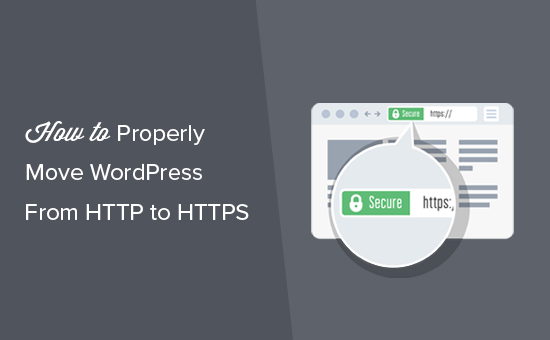
Ecco una rapida panoramica degli argomenti che tratteremo in questo articolo:
- What Is HTTPS?
- Why Do You Need HTTPS and SSL?
- Requirements for Using HTTPS/SSL on a WordPress Site
- Setting Up WordPress to Use SSL and HTTPS
- Method 1: Setup SSL/HTTPS in WordPress Using a Plugin
- Method 2: Set Up SSL/HTTPS in WordPress Manually
- Submit Your HTTPS Site to Google Search Console
- Bonus Resources
- Video Tutorial
Che cos’è l’HTTPS?
HTTPS, o Secure HTTP, è un metodo di crittografia che protegge la connessione tra il browser dell’utente e il vostro server. Questa maggiore sicurezza rende molto più difficile per gli hacker intercettare i dati trasferiti.
Ogni giorno le persone condividono i propri dati personali con i siti web, sia che stiano effettuando acquisti sia che stiano semplicemente effettuando il login. Abbiamo visto in prima persona quanto sia cruciale proteggere questo tipo di scambio di dati.
Per garantire la sicurezza dei dati, è necessario stabilire una connessione sicura.
È qui che entrano in gioco SSL e HTTPS.
Ogni sito web riceve un certificato SSL unico per l’identificazione. Se un server tenta di utilizzare HTTPS senza un certificato valido o se il certificato non corrisponde, la maggior parte dei browser moderni avvisa gli utenti e consiglia loro di non procedere.
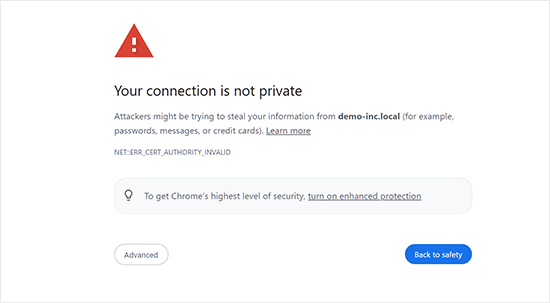
Ora, potreste chiedervi perché sia necessario spostare il vostro sito WordPress da HTTP a HTTPS, soprattutto se si tratta di un semplice blog o di un sito web di una piccola azienda che non effettua pagamenti.
Perché avete bisogno di HTTPS e SSL?
Nel 2018 Google ha annunciato un’iniziativa per aumentare la sicurezza del web, esortando i proprietari di siti a passare da HTTP a HTTPS. Per supportare questa mossa, il browser Chrome ha iniziato a contrassegnare tutti i siti web senza un certificato SSL come “Non sicuro”.
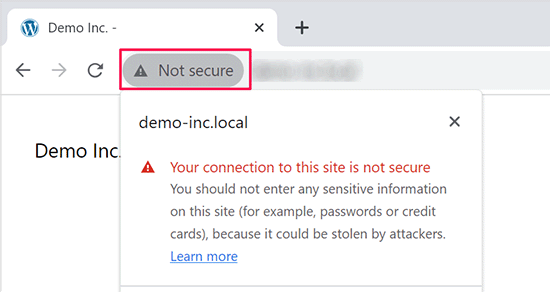
Google ha anche detto che i siti con SSL avrebbero ricevuto vantaggi SEO e avrebbero potuto ottenere un posizionamento di ricerca più alto rispetto ai siti non sicuri. Questo annuncio ha spinto molti proprietari di siti a passare all’HTTPS.
Una volta diffuso l’avviso “Non sicuro”, Chrome ha iniziato a segnalare i siti HTTP. Ad esempio, visitando un sito HTTP in modalità incognito o compilando un modulo di contatto su un sito HTTP si attiva l’avviso, contrassegnandolo come non sicuro.
Quando i visitatori vedono questo avviso, possono lasciare un’impressione negativa del vostro sito o della vostra azienda.
Per questo motivo tutti i siti web devono passare all’HTTPS e installare l’SSL il prima possibile.
Inoltre, l’SSL è indispensabile se si desidera accettare pagamenti online sul proprio sito di e-commerce.
I fornitori di pagamenti come Stripe, PayPal Pro e Authorize.net richiedono una connessione di pagamento sicura.
Ci assicuriamo che i nostri siti utilizzino l’SSL, compresi WPBeginner, OptinMonster, WPForms e MonsterInsights.
Requisiti per l’utilizzo di HTTPS/SSL su un sito WordPress
I requisiti per l’utilizzo di SSL in WordPress non sono molto elevati. Tutto quello che dovete fare è acquistare un certificato SSL, che potreste già avere gratuitamente.
Le migliori società di hosting WordPress offrono certificati SSL gratuiti a tutti i loro utenti:
Per maggiori dettagli, consultate la nostra guida su come ottenere un certificato SSL gratuito per il vostro sito WordPress.
Se il vostro ospitato non offre un certificato SSL gratuito, dovrete acquistarne uno.
Raccomandiamo Domain.com perché offre la migliore offerta di certificati SSL normali e wildcard.
Acquistando un certificato SSL, si ottiene anche un sigillo TrustLogo per il proprio sito web. Ogni certificato SSL viene fornito con una garanzia di sicurezza minima di 10.000 dollari. I prezzi partono da 33 dollari all’anno e i certificati SSL vengono rinnovati automaticamente.
Una volta acquistato un certificato SSL, dovrete chiedere al vostro provider di hosting di installarlo per voi.
Avete bisogno di aiuto per impostare l’SSL e passare all’HTTPS?
Se non avete tempo per impostare l’SSL, il nostro servizio diassistenza Premium WordPress è qui per aiutarvi! Possiamo gestire l’intero processo per voi, assicurandovi che il vostro sito sia sicuro e pronto per i visitatori.
- Tassa una tantum
- Tempi di consegna rapidi
- Disponibile su richiesta 24 ore su 24, 7 giorni su 7
Potete stare tranquilli sapendo che il vostro sito è in mani esperte. Contattateci oggi stesso per un’installazione SSL e una migrazione HTTPS senza problemi!
Impostazione di WordPress per l’utilizzo di SSL e HTTPS
Dopo aver abilitato un certificato SSL per il vostro dominio, dovrete impostare WordPress per utilizzare i protocolli SSL e HTTP sul vostro sito web.
Vi mostreremo due metodi per farlo e potrete scegliere quello più adatto alle vostre esigenze.
Metodo 1: Impostare SSL/HTTPS in WordPress utilizzando un plugin
Questo metodo è più semplice ed è consigliato ai principianti.
Per prima cosa, è necessario installare e attivare il plugin Really Simple SSL. Per maggiori dettagli, consultate la nostra guida passo passo su come installare un plugin di WordPress.
Dopo l’attivazione, è necessario visitare la pagina Impostazioni ” SSL. Il plugin rileverà automaticamente il vostro certificato SSL e imposterà il vostro sito WordPress per l’utilizzo di HTTPS.
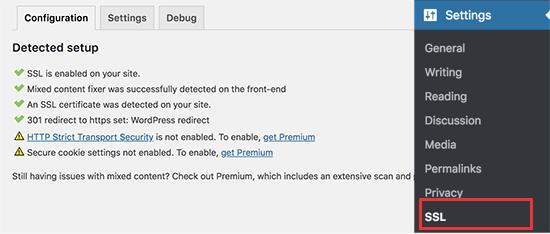
Il plugin si occuperà di tutto, compresi gli errori di contenuto misto. Ecco cosa fa il plugin dietro le quinte:
- Controllare il certificato SSL
- Impostate WordPress per utilizzare https negli URL
- Impostazione di reindirizzamenti da HTTP a HTTPS
- Cercate nei vostri contenuti gli URL che vengono ancora caricati da fonti HTTP non sicure e cercate di risolverli.
Nota: il plugin tenta di risolvere gli errori di contenuto misto utilizzando una tecnica di buffering dell’output. Questo può avere un impatto negativo sulle prestazioni, perché sostituisce il contenuto del sito mentre la pagina viene caricata. Questo impatto è visibile solo al primo caricamento della pagina e dovrebbe essere minimo se si utilizza un plugin per la cache.
Anche se il plugin dice che è possibile mantenere SSL e disattivare il plugin in modo sicuro, non è vero al 100%. Dovrete lasciare il plugin sempre attivo perché la disattivazione del plugin riporterà gli errori di contenuto misto. Per maggiori dettagli, consultate la nostra recensione di Really Simple SSL.
Metodo 2: Impostazione manuale di SSL/HTTPS in WordPress
Questo metodo richiede la risoluzione manuale dei problemi e la modifica dei file di WordPress. Tuttavia, è una soluzione permanente e più ottimizzata dal punto di vista delle prestazioni e la stiamo utilizzando su WPBeginner.
Se trovate questo metodo difficile, dovreste assumere uno sviluppatore WordPress o utilizzare il primo metodo.
Potrebbe essere necessario modificare il tema di WordPress e i file di codice come parte di questo metodo. Se non l’avete mai fatto prima, consultate la nostra guida su come copiare e incollare frammenti di codice in WordPress.
Per prima cosa, è necessario visitare la pagina Impostazioni ” Generale. Da qui, è necessario aggiornare i campi dell’indirizzo URL di WordPress e del sito sostituendo http con https.
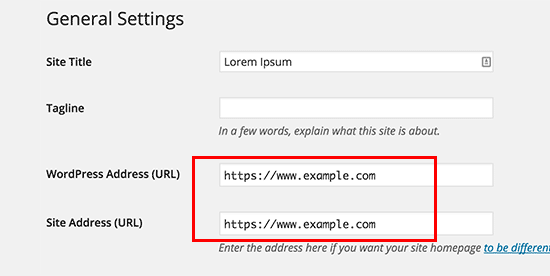
Non dimenticate di fare clic sul pulsante “Salva modifiche” per memorizzare le impostazioni.
Una volta salvate le impostazioni, WordPress vi farà uscire e vi chiederà di effettuare nuovamente il login.
Successivamente, è necessario impostare il reindirizzamento di WordPress da HTTP a HTTPS aggiungendo il seguente codice al file .htaccess:
1 2 3 4 5 | <IfModule mod_rewrite.c>RewriteEngine OnRewriteCond %{HTTPS} offRewriteRule ^(.*)$ https://%{HTTP_HOST}%{REQUEST_URI} [L,R=301]</IfModule> |
Se si utilizzano server NGINX, è necessario aggiungere il seguente codice per reindirizzare da HTTP a HTTPS nel file di configurazione:
1 2 3 4 5 | server {listen 80;server_name example.com www.example.com;return 301 https://example.com$request_uri;} |
Non dimenticate di sostituire example.com con il vostro nome di dominio.
Seguendo questi passaggi, eviterete l’errore WordPress HTTPS not working perché WordPress ora caricherà l’intero sito web utilizzando HTTPS.
Se si desidera forzare SSL e HTTPS nell’area di amministrazione di WordPress o nelle pagine di login, è necessario configurare SSL nel file wp-config.php.
Aggiungete il seguente codice sopra la riga “That’s all, stop editing!” nel file wp-config.php:
1 | define('FORCE_SSL_ADMIN', true); |
Questa riga consente a WordPress di forzare SSL/ HTTP nell’area di amministrazione di WordPress. Funziona anche sulle reti multisito di WordPress.
Una volta eseguita questa operazione, il sito web è completamente configurato per l’utilizzo di SSL/ HTTPS, ma si verificheranno ancora errori di contenuto misto.
Questi errori sono causati da fonti (immagini, script o fogli di stile) che vengono caricate utilizzando il protocollo HTTP non sicuro negli URL. In questo caso, non è possibile vedere l’icona del lucchetto sicuro nella barra degli indirizzi del sito web.

Molti browser moderni bloccano automaticamente gli script e le risorse non sicure.
Potreste vedere un’icona a forma di lucchetto, ma con una notificazione su chi siamo, nella barra degli indirizzi del browser.
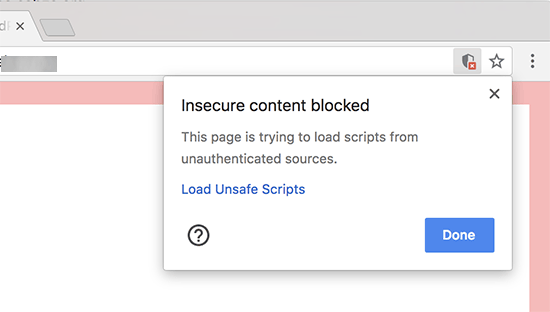
È possibile scoprire quali contenuti sono serviti attraverso un protocollo non sicuro utilizzando lo strumento Inspect.
L’errore di contenuto misto viene visualizzato come un’attenzione nella console con dettagli per ogni elemento di contenuto misto.

Si noterà che la maggior parte degli URL sono immagini, iframe e gallerie di immagini, mentre alcuni sono script e fogli di stile caricati dai plugin e dai temi di WordPress.
Correggere il contenuto misto nel database di WordPress
La maggior parte degli URL errati sono immagini, file, embed e altri dati memorizzati nel database di WordPress. Per prima cosa correggiamoli.
La cosa migliore sarebbe trovare nel database tutte le menzioni del vecchio URL del sito web che iniziano con HTTP e sostituirle con il nuovo URL del sito web che inizia con HTTPS.
È possibile farlo facilmente installando e attivando il plugin Search & Replace Everything. Per maggiori dettagli, consultate la nostra guida passo-passo su come installare un plugin di WordPress.
Dopo l’attivazione, è necessario visitare la pagina Strumenti ” WP Search & Replace. Nel campo “Cerca”, dovete aggiungere l’URL del vostro sito web con http. Successivamente, aggiungere l’URL del sito web con https nel campo “Sostituisci”.

Di seguito, vengono visualizzate tutte le tabelle del database di WordPress.
È necessario selezionarli tutti per eseguire una verifica approfondita.

Quindi, fare clic sul pulsante “Anteprima di ricerca e sostituzione” per vedere tutte le modifiche apportate dal plugin.
Infine, fare clic sul pulsante “Sostituisci tutto”.
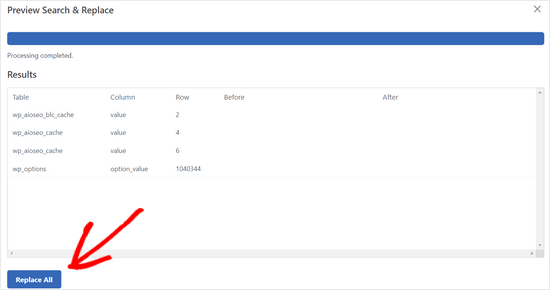
Il plugin cercherà ora nel database di WordPress gli URL che iniziano con http e li sostituirà con URL sicuri https. Potrebbe essere necessario un po’ di tempo, a seconda delle dimensioni del database di WordPress.
Correzione degli errori di contenuto misto nel tema WordPress
Un’altra causa comune degli errori di contenuto misto è il tema di WordPress. Qualsiasi tema WordPress decente che rispetti gli standard di codifica di WordPress non causerà questo problema.
Per prima cosa, è necessario utilizzare lo strumento di ispezione del browser per trovare le risorse e la loro provenienza.

Successivamente, dovrete trovarli nel vostro tema WordPress e sostituirli con https. Questa operazione sarà un po’ difficile per la maggior parte dei principianti, poiché non sarà possibile vedere quali file del tema contengono questi URL.
Correzione degli errori di contenuto misto causati dai plugin
Alcune risorse a contenuto misto vengono caricate dai plugin di WordPress. Qualsiasi plugin di WordPress che rispetti gli standard di codifica di WordPress non causerà errori di contenuto misto.
Non consigliamo di modificare i file dei plugin di WordPress. Dovreste invece contattare l’autore del plugin e farglielo sapere. Se non rispondono o non sono in grado di correggere il problema, è necessario trovare un’alternativa adeguata.
Nota: se per qualche motivo si verifica ancora un errore di contenuto misto, si consiglia di utilizzare temporaneamente il plugin Really Simple SSL, in modo che gli utenti non ne risentano mentre si corregge il problema su un sito web di staging o si assume uno sviluppatore.
Inviate il vostro sito HTTPS a Google Search Console
I motori di ricerca come Google considerano https e http come due siti web diversi. Per evitare problemi di SEO, è necessario comunicare a Google che il sito web è stato spostato.
Per farlo, è sufficiente accedere all’account di Google Search Console e fare clic sul pulsante “Aggiungi proprietà”.

Si aprirà una finestra a comparsa in cui dovrete aggiungere il nuovo indirizzo https del vostro sito web.
Esistono due metodi per la verifica del sito: il nome di dominio o il prefisso URL. Consigliamo il metodo del prefisso URL perché è più flessibile.
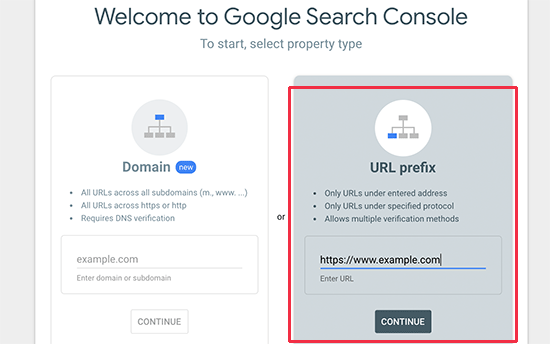
Successivamente, Google vi chiederà di verificare la proprietà del vostro sito web.
Ci sono diversi modi per farlo. Selezionate un metodo qualsiasi e riceverete le istruzioni per verificare il vostro sito. Si consiglia di utilizzare il metodo dei tag HTML.
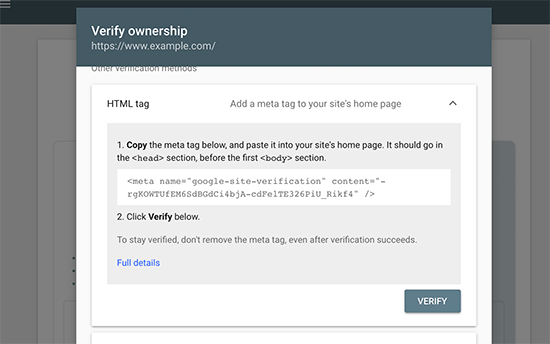
Ora vedrete uno snippet di codice HTML da aggiungere alla sezione head del vostro sito web WordPress.
Aggiungere il codice di verifica di Search Console utilizzando All in One SEO
Innanzitutto, installate e attivate il plugin All in One SEO for WordPress. Per maggiori dettagli, consultate il nostro tutorial su come installare un plugin di WordPress.
Nota: esiste anche una versione gratuita di All in One SEO che potete provare.
Dopo l’attivazione, accedere alla pagina All in One SEO ” Impostazioni generali e fare clic su Google Search Console.

In seguito, è necessario aggiungere il codice di verifica copiato in precedenza dal sito web di Google Search Console.
Non dimenticate di cliccare sul pulsante “Salva modifiche” per memorizzare le impostazioni.
Quindi, tornare alla scheda Google Search Console e fare clic sul pulsante “Verifica”.

Una volta che il sito è stato verificato, Google mostrerà qui i rapporti della Search Console.
È inoltre necessario assicurarsi che entrambe le versioni https e http siano aggiunte alla Search Console.
Questo indica a Google che volete che la versione https del vostro sito web sia trattata come la versione principale. In combinazione con i reindirizzamenti 301 impostati in precedenza, Google trasferirà le classifiche di ricerca alla versione https del vostro sito web e molto probabilmente vedrete dei miglioramenti nelle vostre classifiche di ricerca.
Risorse bonus
Di seguito sono riportate alcune risorse aggiuntive che possono aiutarvi a risolvere da soli i problemi comuni di WordPress e a saperne di più su WordPress:
- Come correggere i problemi SSL più comuni in WordPress (Guida per principianti)
- Gli errori più comuni di WordPress e come risolverli
- TLS vs SSL: quale protocollo utilizzare per WordPress?
- Come correggere l’errore di connessione sicura in WordPress
Video tutorial
Speriamo che questo articolo vi abbia aiutato ad aggiungere HTTPS e SSL in WordPress. Potreste anche voler consultare la nostra guida definitiva alla sicurezza di WordPress con istruzioni passo-passo per mantenere sicuro il vostro sito WordPress o come rinnovare il vostro certificato SSL.
Se questo articolo vi è piaciuto, iscrivetevi al nostro canale YouTube per le esercitazioni video su WordPress. Potete trovarci anche su Twitter e Facebook.





Kevin Bollhorst
Thank you for this informative article. I am looking into switching my blog to SSL. The web host provider is Bluehost and I am using the free Cloudflare CDN Service. I have one question. Will Cloudflare’s free service support Bluehost’s Free SSL certificate?
WPBeginner Support
Hi Kevin,
Please contact Bluehost or Cloudflare support, you may need additional configuration for SSL to work with your free Cloudflare CDN.
Admin
Moritz Steiger
I followed these instructions and now it has screwed my site, nothing works. I now get the ‘White screen of death’ my host won’t help as they say it is a coding error and I am left in limbo.
WPBeginner Support
Hi Moritz,
We are sorry to hear that. Please undo the steps you took while following the tutorial one by one and that should fix your site to normal.
Admin
Chandra
Hi,
Thank for you for such an detailed article on a very hot topic.
I followed manual steps but got mixed content error. And seems because of this I’m not able to see WP login page. I tried clearing cache on dreamhost but message displayed is “Unable to connect to CloudFlare”.
I’m using Dreamhost and Cloudflare is enabled.
Could you please help or need more details to fix the issue? Do you also offer paid service to secure another site of my mine?
Thank You.
WPBeginner Support
Hi Chandra,
Please review your Cloudflare settings.
Admin
Richard
Hi,
Just followed through the manual procedure without problems – Thanks!
However, I’ve noticed that If I type the old http:// address into the browser for any page except for the homepage then the old http:// page loads.
Then when I click a link to another page it goes to a https:// page is this normal?
Does it indicate a problem with the redirect?
WPBeginner Support
Hi Richard,
No it is not. Most likely the redirects in your .htaccess file are not working. Try copying the code and adding it to your .htaccess file again and see if this resolves the issue.
Admin
Richard
Hi,
Fixed It thanks. I’d originally inserted the Code at the end of the htaccess file. Moved It Up to before the WP section and everthing now works correctly.
Thanks for your help and for the concise guide. I’d been putting this off for a while.
Daniel
With regard to the last step in Google Console, on the “Change of Address” page, I am getting a “no available sites” message, but I have double-checked that my http and https versions are verified. When I click on “add it now” I’m just getting verification information. What do I do?
Emily Randall
I just installed a LetsEncrypt cert on my website, and I’m getting a bunch of insecure content errors that shouldn’t be happening. Although the theme is using get_template_directory_uri() to load its styles and scripts, those styles and scripts are still being loaded via http, not https. Even if I hard-code the https url in the function to load the styles/scripts, they’re loaded via http.
Do you have any idea what’s happening here? As far as I can tell, everything is set up properly, but it’s not working.
WPBeginner Support
Hi Emily,
Try clearing WordPress cache.
Admin
skaur
Hi,
I have purchase SSL and configured by my hosting. It shows https in url. when I do https under General settings in wordpress admin area, my website goes down, only homepage and after it I am not able to login the admin area too. I added the code in htaccess file too with https under settings.
Could you help me with this?
Thanks
stan
https://support.google.com/webmasters/answer/83106 says that
Note: The tool does not currently support the following kinds of site moves: subdomain name changes, protocol changes (from HTTP to HTTPS), or path-only changes.
WPBeginner Support
Hi Stan,
Yes, we are aware of that. However, we still recommend taking this step. It is safe and will not have any negative impact on your site.
Admin
Lindsey Bell
I use Bluehost for web hosting and just set up my wordpress site with their free SSL certificate through the Bluehost page. There was a page on the Bluehost site to activate it for my WordPress site. Now, it appears that my site is already set up with the https. Do I still need to install the plug in, or is mine already taken care of? Thanks so much for the help!
WPBeginner Support
Hi Lindsey,
You still need to install the plugin.
Admin
Farukh hussain
Hi,
I was founding this issue and you just uploaded this article. Thanks alot.
Can you please help? I did not change my primary site on search console. I added a new property with https and then created a set for all of them. Will it work fine for ranking or I need to follow your instructions only???
WPBeginner Support
Hi Farukh,
Adding HTTPS property and then redirecting users from HTTP to HTTPs will work fine.
Admin
Paula Jones
So I have to purchase a dedicated IP address to use the free SSL certificate?
WPBeginner Support
Hi Paula,
No, you don’t need a dedicated IP address to use free SSL certificate.
Admin
Chris
I don’t understand why a redirect is still necessary once the hosting service installs the certificate for the site. I’m assuming that a WordPress site initially configured with the HTTPS protocol does not require a redirect. Is it a matter of registering a domain with or without the proper protocol?
James Katt
The problem of buying an SSL certificate and having it installed is that you will need to also purchase a fixed IP address from your Web Host. This is an additional yearly cost on top of the yearly cost of the SSL Certificate. For each website you create you have to buy an SSL certificate and a fixed IP address. This will add up tremendously the more websites you have.
Because of this, I prefer creating websites on hosts that Automatically give you a Free SSL certificate. These days, the ones that don’t simply want to gouge you for money.
Rupam krishna Bharali
Can the internal configuration of SSL and HTTPS help to reduce the SSL loading time during a request? When I tested my website with SSL enabled and it took about 455 ms to load “the SSL separately”, but when I disabled the SSL total loading time decreased to 1.3s. So two question I want to ask you guys,
1. Can I go without an SSL just because I have a Simple blog, no commercial stuff, and web payments?
2. Can the configuration of SSL internally with the help of .htaccess file reduce the loading time of SSL?
WPBeginner Support
Hi Rupam,
1. You can but soon Google will start warning users about websites not using HTTPs, this would affect your website’s traffic.
2. Yes, it can. You can also try to avoid plugins to fix mixed content issues. We have noticed that often such plugins increase page load time significantly.
Admin
Adeshewa
Could someone help please, I followed the direction of the first one all my pages are secure except for one on the menu. Whenever I clicked on it as a customer it says your connection to this website isn’t encrypted.
Troy
Not sure if you got this fixed yet, but I was having the same issue. I found that using the SSL Insecure Content Fixer plugin corrected it. Worth a shot!
Shyam
Hi wpbeginner,
My website did not have ssl certificate. I changed the http to https now it is showing ssl not enabled. What do I do?
Zohaib Sadique
If you are working in WordPress then install the plugin named “really simple SSL” to force up your SSL. I hope you will get the idea. Thanks for reading.
Erin
Thank you!! Finally I have my SSL certificate recognised by wordpress and I couldn’t have done it without the info provided here. So a BIG thanks for helping me out!
Farrukh Ghafoor
I have added the code into the .htaccess file but when I refresh my page in WordPress it comes up with a “Your connection is not private” message. I have to click on “Back to safety” and the icon does not appear in the website url. Please help me to fix this. Thanks
Marco
Where do you install WordPress? public_html or private_html ?
WPBeginner Support
Hi Marco,
You need to install WordPress in public_html folder.
Admin
Cecilia W
I followed the first step, adding the https: to the website name and immediately the webpage redirected me to a sit not secure error prompt and now I can’t access my dashboard at all to finish the process or do any bug fixes. How do I reverse the first step?
Mark Lewis
Thank you for this helpful article
Tammy
I have used your site for a resource for a long time. Therefore, I was confident when I followed the directions in this article–to the letter. I used it on a client’s site. Which seemed to work perfectly. Then my own site. However, now I am locked out of both sites. I have a backup of them using the WP all-in-one migration plugin, but no way to access the dashboard.
One site says too many redirects. Even when going to an incognito window or a browser where I’ve recently deleted all history, it still says delete all cookies. The other site says can’t connect to server.
Any suggestions for me? I am pretty screwed at this point.
Thanks,
Tammy
WPBeginner Support
Hi Tammy,
Please see our article on how to fix too many redirects issue in WordPress.
Admin
Sukka
Does my backlinks gets lost after change. Kindly some one clears it to me.
As when I checked my website through semrush https is showing 0 backlinks but I actually have 1000+ backlinks.
Please someone guide.
Thanks.
dan
Why doesn’t the .htaccess stuff for Apache contain the 301 redirect information?
Divine
This was really helpful. Though after doing it, it showed 404 in most pages but when I updated the paramalink…it was solved
Pipy
Please, I am looking for some ways that I can do to secure the WordPress website from hackers and becoming a secure site. Suggest please
WPBeginner Support
Please see our ultimate WordPress security guide.
Admin
Ravi
Hey wpbeginner team why you guys are not using ssl certificate.?
Waiting for your answer.
Reo
Let me answer that. WPBeginner no need to use SSL because they don’t have a login/signup page and ecommerce.
SaifZiya
But, hasn’t Google now announced that having an SSL certificate can boost your rankings in SERPS?
Cristi Adam
Thank you for info man, great article, it really fixed my issue
Amar Patel
after adding ‘s’ to the WordPress URL and site URL redirection is working properly…I removed the ‘s’ and put redirection code in my .htaccess then browser saying error too much redirection.
If i go for first option that will be fine or not ?….how can in know my redirection working properly ?
Nalin
Hi,
Is it necessary to include the code in htaccess? I am using wordpress and checked with whynopadluck and manually changed the link of the images with non https link. After that, it shows all items are secure. Do I still need to update htaccess? Doesn’t WordPress redirect http to https by itself?
Mottaqi
If I install a new WordPress installation for a new site should I do all of these???
Abiola Oyeniyi
Cloudflare SSL or Let’s Encrypt which one is the best. I had to switch to Cloudflare SSL
Mukesh Patel
If you are using cloudflare than you can easily switch your site to HTTPS. If you are using free plan then their are no option available for use custom SSL. If you install Let’s Encrypt SSL on origin server, Even after that browser will show Cloudflare SSL.
Richard
Very helpful article. However, I am wondering if I would still be required to update the .htaccess file (per your example) if I am using the plugin: “Really Simple SSL” that you recommended in a newer article. (Also, would this plugin take care of changing the WP General Settings?)
Thanks!
James
We completed step 1 and now we cannot login to our wordpress to do step 2 or 3. And the only page that works on our site it the home page. All other pages try to pull up as https and gives an error. We have to manually take the s out so it’s http before the page will show.
We’ve undone the first step and still cannot login. We are dead in the water here.
Jerome Williams
Worked great. For people with self-signed certs yeah, you will get an error. But if you get that warning, that means you followed this tutorial correctly! All you have to do now is resolve your SSL signing issue and you’re set.
Bhupesh Pant
Hi After making the above changes I am not able to open my site, I am not even able to login to my wp- admin page to revert https to http please help.
Enyel Cuadro
(GoDaddy)
define(‘FORCE_SSL_ADMIN’, true);
after adding this line then reload the website, I got error that “your connection is not private”. I am using self-signed certificate. Please help how to setup https using self-signed certificate.
Kimball
Do a view source on your page. See anything that starts with http:// like css, js, or image files? Those will have to be changed in your content or template.
Mukesh Patel
Do not use self-signed-certificate. You can choose Let’s Encrypt SSL, Free Comodo Certificate or Cloudflare SSL. These all are free of cost.
Ali O
I know that WPBeginner is great, but you exceeded my expectations and totally saved my week today with this how-to guide! Love you guys!
Red Strivens
Remember to change the Port as well !!!!
Mari-Lyn
Thank you for the simple explanation of making a site ssl compliant.
Bala krishna reddy mogiligundla
Sir i have stuck in a problem i hope you could help , i have a hosting which is worth $300 in godaddy i have added one website and bought an ssl for that …again after some days i have added secondary site avantsolutions.ca to same hosting . i have been told that i cannot buy additional ssl to this hosting and suggested me to buy one unified ssl which costs around 350$ .Please dont mind me saying this but i have already spent alot and cant afford that ..what other options do i have
WPBeginner Support
Hello Bala Krishna,
Please try to resolve it with your hosting provider through live chat or phone support. If you have purchased a hosting plan that doesn’t meet your needs, then you can ask them for a refund. Most hosting companies have some sort of refund policy which is usually valid during the first 30 days of signup.
Admin
Lydia
Hi, my host offers the Let’s encrypt so I have gone that route, as this is all new I have created a new site to practice on which i set up the lets encrypt shared ssl. Now I am trying to move it from http to https I did install the simple ssl plugin but it did not find my ssl certificate, not sure if it is set to work with shared lets encrypt so, i found another plugin called wp encrypt which is designed specifically for the shared lets encrypt but i am not able to get it to connect the way it instructs. I have checked my outgoing connections and they are clear. Would appreciate any help in working this process out, so I can get started on the shift. Thanks
Max
Followed the instructions and basically bricked my website.
between 404 errors, database connection errors and more and more errors… that 301 redirect causes way too many problems.
Brian Luff
Thanks for the article, which is interesting and informative. There’s one problem it doesn’t mention, and no-one else has commented so I wonder if I’m missing something.
I bought a third-party SSL certificate from the hosting company and switched to HTTPS. After making the .htaccess changes, everything worked fine, except…
None of the pages get a green padlock. Instead, there’s an info link that says the pages are ‘partially secure’.
I checked with the hosting company, and they said I had to change every internal link to HTTPS, and the URL of every image likewise. If I don’t do that, then no green padlock.
Manually making all those changes would take me months even if I worked 8 days per week, 25 hours per day. If I’d known that at the outset, I would not have made the change to SSL/HTTPS in the first place.
Is what I’m being told correct? If so, is there any (even semi-)automated way of updating all the links in the site?
WPBeginner Support
Hi Brian,
You can install Really Simple SSL plugin and it will take care of partially insecure links on your website.
Admin
Brian Luff
Many thanks for that, I’ll remember it for next time (I have a personal blog I’m thinking about moving from .com to .org). In this case I already bit the bullet. It turns out I was exaggerating but it did take me several hours to go through 200 posts and 70 pages manually changing all the internal links and the image references. At the end of all that, there was still no green padlock, but I found the last few instances using a useful (free) tool (which may or may not be a useful adjunct to your plugin). I now have another question, but I’ll post it separately for clarity. Thanks again for responding.
WPBeginner Support
Hi Brian,
Glad to know that you fixed it
Felix
Hi Brian,
There is another ultimate solution for that problem. Try to make Backup of MySQL database of your site manually by the procedure:
https://www.wpbeginner.com/beginners-guide/how-to-make-a-wordpress-database-backup-manually/
OR.
Almost any hosting provider has an option such as “download MySQL database” or “dump MySQL database”. You will download .sql file. After that open that .sql file in text editor such notepad++ and try the find-replace function to find “http” and replace it by “https”. It will take a second.
hiren
hii,
I does the changes as above in my site but now it is getting problem ” Error establishing a database connection”
so i’ve no idea where to do changes .
pls help. thanks in advance.
Lisbeth
What to do if I want to revert back from https to http?
There aren’t many guides on this one. Please help.
Tom W
A quick update – there is a free plugin called Really Simple SSL that you can download, activate, and it works great!
Many thanks to the author.
Jason
I tried this and had a problem. I switched from a basic html/htm site to wordpress so my .htaccess has a lot of 301 redirects. No I’ve bought an SSL In the current setup if I add RewriteRule ^(.*)$ to the .htaccess file then if anybody attempts to browse the site they get “the webpage has a redirect loop” error. So I’ve had to take out that line of code. Anything I can do?
Avinash Kumar
I am using cloudflare for https and want to know how to display “secure lock sign” before the https:// and I also want to know why you are not using https ?
hiren
Just install a Really simple SSL plugin and active it. and change in the yor site general setting it is Setting >> General >> https://example.com
Mukesh Patel
Hello Avinash Kumar.
wpbeginner don’t use HTTPS because they don’t have any login, signup page and also don’t sale anything.
WPBeginner Support
Hi Avinash and Mukesh,
Actually, we have moved to HTTPS recently.
Admin
Bart Nash
When configuring the SSL certificate, is it better to add the www to https:// or leave off the www when setting up a new wp site.
WPBeginner Support
Hi Bart,
See our guide on www vs non-www.
Admin
tim
Reason when I complete all the steps. Thank you for your article! I was wondering though, my website recently has suffered some problems with.